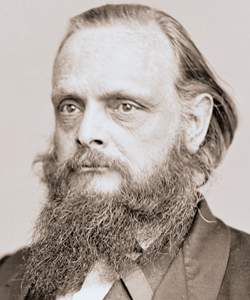John Curtiss Underwood (American National Biography)
Scholarship
Underwood was an ardent abolitionist and active in the Whig, Liberty, and Free Soil parties. In the spring of 1848, after several unsuccessful attempts at elective office in New York, he turned his attention southward to western Virginia, where he established over fifteen farms utilizing free labor. He hoped, in concrete terms, to demonstrate that the South need not rely economically on the immoral institution of slavery. Although these farms ultimately failed, his efforts represent a rare attempt by a northern abolitionist to go South and create pragmatic alternatives in order to effectuate change in southern society.
After delivering a speech critical of Virginia and slavery at the 1856 Republican National Convention, Underwood was strongly "advised" not to return to his home in western Virginia. While following this advice, he campaigned for the Republican presidential candidate, John C. Frémont, and continued to write and speak out against slavery. He eventually moved to New York City. Underwood's new project was organizing the American Emigrant Aid and Homestead Company, which sought to establish antislavery communities in western Virginia. The purpose of the company was twofold: to foster abolitionist sentiment among the western Virginians and to demonstrate, again, that communities based upon free labor could prosper in the South. This effort, begun with great optimism in 1857, could not sustain itself in the hysteria following John Brown's raid on Harper's Ferry in 1859 and the subsequent Civil War.
After delivering a speech critical of Virginia and slavery at the 1856 Republican National Convention, Underwood was strongly "advised" not to return to his home in western Virginia. While following this advice, he campaigned for the Republican presidential candidate, John C. Frémont, and continued to write and speak out against slavery. He eventually moved to New York City. Underwood's new project was organizing the American Emigrant Aid and Homestead Company, which sought to establish antislavery communities in western Virginia. The purpose of the company was twofold: to foster abolitionist sentiment among the western Virginians and to demonstrate, again, that communities based upon free labor could prosper in the South. This effort, begun with great optimism in 1857, could not sustain itself in the hysteria following John Brown's raid on Harper's Ferry in 1859 and the subsequent Civil War.
Michael Powell, "Underwood, John Curtiss," American National Biography Online, February 2000, http://www.anb.org/articles/11/11-00866.html.
John Curtiss Underwood, Legacy (American National Biography)
Scholarship
Underwood attracted attention in both the North and South during his lifetime. Northern editors, politicians, and abolitionists applauded his attempts to reform the South. At the same time, he was viewed by southerners with contempt for his position on slavery and for the opinions he issued from the bench. While Underwood, who lived his last years in Alexandria, Virginia, but died in Washington, D.C., has been labeled as a Radical Republican carpetbagger, more recent historiography portrays him as an advocate of equality and freedom of expression. His concrete antebellum attempts to employ free labor in the South set him apart from many abolitionists; his efforts after the Civil War reflect his continued interest in the freedom and equality of all Americans.
Michael Powell, "Underwood, John Curtiss," American National Biography Online, February 2000, http://www.anb.org/articles/11/11-00866.html.



